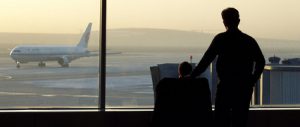Under EU plans, delayed this week, Chinese flights will be obliged to pay for aviation emissions allowances for flying to and from Europe. The move has caused uproar in China, with some going as far as to suggest it is a ploy by the EU to raise revenues as it deals with a sovereign debt crisis.
The aviation tax actually has its origins in The EU Emission Trading Scheme (EU ETS), established in 2005, and followed in November 2008 by legislation stipulating that all carbon emissions from international and domestic flights arriving in or departing from an EU airport (as well as Iceland, Liechtenstein, Norway and Croatia) must abide by the EU ETS, starting on January 1, 2012.
Under the plans, all international airlines operating in Europe, except for airlines from 23 countries too small to meet the minimum emission threshold, would have to apply for carbon emission allowance on the basis of their annual carbon emissions. Otherwise, the airline could face punishment from the EU, including the possibility of their planes being grounded.
Policy efforts to reduce carbon emissions in the international aviation sector are hardly unique to the EU. The International Civil Aviation Organization (ICAO), a multilateral institution affiliated with the UN, initiated a similar policy as early as the 1990s. However, little progress has been made since then. The EU has taken the lead in order to push the ICAO toward a global consensus.
In March 2012, ICAO proposed four possible market-based solutions. More importantly, it aimed to draft an overall framework that contained concrete mechanisms for reducing aviation emissions globally to replace the EU’s proposed measures under the EU ETS. This was expected to be done at the ICAO’s official assembly in September 2013. However, given the limited progress the organisation has achieved over previous years and significant disagreements among its member countries, the prospects for the ICAO’s efforts moving forward are dim.
Fierce reaction
The EU has been surprised by the fierce objection to its efforts to tackle aviation emissions. In 2009, the EU was sued by several US airlines for violating The Chicago Convention on International Civil Aviation. Although the US airlines lost the case at the European Court of Justice, it was followed by further outcry against the legislation from other countries. The 2011 climate summit of the BASIC nations (Brazil, South Africa, China and India) issued an official objection to the EU’s carbon “tax” on international aviation. Following this, 29 countries including China, the United States, India and Russia issued a joint declaration at a conference in Moscow, officially denouncing the EU ETS. The 29 countries also proposed another round of counter-measures to the EU’s legislation. Meanwhile, several major European airlines have been rumoured to be quietly protesting the EU ETS legislation, yet the EU continues to refuse to compromise on this issue.
As the debate heats up, the Chinese public as well as the media are for the first time learning about a piece of legislation that might have a substantive impact on Chinese travels to and from Europe. Perhaps unsurprisingly, a number of misunderstandings are being repeated in the media, adding to the political deadlock on the issue. They can be summarised under four headings:
1) The EU is charging airlines an “aviation tax”
Under the EU ETS, aircraft operators are obliged to submit carbon emission data that is based on their actual emissions. This allowance for emissions, however, is tradable so airlines can decide to buy or sell the allowance based on their own situation rather than paying at fixed tax rate. The total numbers of allowances for the aviation sector operating in the EU in 2012 is about 97% of the annual average aviation emissions for 2004 to 2006. From 2013 to 2020, this percentage will fall to 95%.
In 2012, 85% of the allowances will be given for free to aircraft operators and 15% of the allowances will be allocated by auctioning. From 2013, 82% will be granted for free while the remaining 3% will be kept in a special reserve for the needs of rapidly growing airlines and new airlines entering the market. Free allowances will be distributed according to each airline’s emissions share in 2010.
Airlines, therefore, only need to pay for emissions that exceed their free allowances and future growth. If airlines take measures to cut their emissions and stay under their allowances, they will not need to pay and can even profit from selling their extra allowances. Another item in the legislation is that if a country implemented an “equivalent measure” to the EU ETS aviation legislation, their flights to the EU then could be exempted from the EU ETS.
2) The legislation is intended to save the EU economy
Several Chinese media publications have argued that the EU’s move on aviation stems from its severe sovereign-debt crisis and shrinking EU ETS market. In other words, the EU is implementing this to generate income. But the truth of the matter is that the EU proposed including the aviation sector in the system as early as 2005, when the EU ETS was still in its earliest stages.
While the EU domestic aviation sector was included in the emission-reduction target under the Kyoto Protocol, the international aviation sector was free from any restraints in its carbon emissions. But given the size of the international aviation sector’s carbon emissions and the rapid growth of this industry, the EU believed it necessary to include it into the EU ETS. The law that specifies that aviation would be included in 2012 was first brought up for consideration by the EU in 2006 and received approval at the end of 2008. It is farfetched to connect the legislation to the difficulties that the EU is facing today.
3) The legislation will constrain the aviation sectors of developing countries
Airlines from emerging economies, such as China and India, object to the legislation mostly on grounds that it will limit the expansion of their airlines in Europe as their economies continue to grow. Mature airlines from developed economies will not grow as much, therefore emerging economies view the legislation as an unfair restraint on their potential market growth in Europe.
However, the international aviation market is highly globalised. Airlines from European countries, not just developing countries, are all trying to increase their share of the growing aviation market. It is unlikely that any airlines will take a hit on their market growth because of the slight increase in costs from emission allowances. International passengers also have the freedom to choose among different airlines, and so the demand for emission allowances may increase uniformly for all airlines, not just airlines from developing countries. It is not only the airlines from developing countries that will be affected by the new legislation.
Moreover, passengers who take international airlines come from all over the world and are relatively wealthy. Bearing this in mind, it seems unsuitable to apply the principles of “common but differentiated responsibilities” to them according to their nationality. In fact, purchasing emissions allowances will cost no more than 20 euros per passenger, an amount airlines can easily add to the ticket price. As all aviation operators are included under this new legislation, the increase in costs will barely impact an airline’s competitiveness.
4) The EU ETS is opposed by many key nations
Although countries like the US, Russia, India and China all strongly opposed the legislation at international conferences, domestic policy actions tell a different story. Both Houses of US Congress passed a bill each blocking American airlines from participating in the EU ETS, but none of them is effective yet. After losing their lawsuit against the EU, the US airlines have stopped using legislative measures to do battle. Even though US government displays a strong objection to EU ETS, the political cost of further confrontation is too high.
Nor have the Russian and Indian governments taken coercive measures to boycott the EU or support their airlines’ outcry against the EU ETS. So far, India’s Ministry of Civil Aviation has only issued a declaration that “Indian airlines do not need to submit emissions data to the EU”. Meanwhile, Russian airlines have quietly handed in their emissions data.
In comparison, the Chinese government has taken a much more assertive stance. The Civil Aviation Administration of China issued an order in February 2012, which “prohibits Chinese airlines from participating in the EU ETS without approval from relevant governmental departments.” By issuing this order, China is the only country to challenge the EU directly and officially. In spite of their own disputes with the EU ETS, the United States, Russia and India have all hung back from confronting the EU directly, hoping to benefit from the Sino-EU dispute.
Strategy for the future?
The latest news is that the EU plans to put implementation of the legislation on hold until November 2013, in an attempt to create “a positive atmosphere” to help the ICAO reach a global deal.
If the ICAO fails, the EU will automatically resume enforcement. This will gain some extra time for a global deal, but the situation is still pressing given the limited window and the task in hand. It will take all parties involved to act calmly and wisely to reconcile this political gridlock and prevent further confrontation.
Read also: Eight major challenges for China’s new leaders
The EU needs to realise that implementation of the legislation still faces numerous potential problems. For example, voices and opinions from developing countries were largely overlooked when the legislation was first enacted; the use of revenue generated by auctioning emission allowances is not subject to international supervision, which creates a transparency issue. Moreover, the legislation is not flexible enough: the “equivalent measures” according to which exemptions are granted are vaguely defined and unilaterally decided by the EU, which indirectly renders the confrontation very hard to resolve.
Meanwhile, emerging economies need to realise that the EU’s effort to include international airlines in the emissions trading system is not targeted at them. The intention is to reduce carbon emissions while minimising damage to the EU’s own aviation industry. As Europe continues with its economic struggles, it is not politically feasible to force 27 EU members to revise or even abolish the legislation, especially at the expense of their own aviation industry. In addition to pushing international civil aviation organisations to reach a global consensus, China and the EU should engage in active bilateral negotiations to reconcile their dispute.
If the dispute remains unresolved, the confrontation will likely spiral into even heavier costs for both the EU and China as neither side can afford a political blow or policy concession under the other’s pressure. This will not only severely damage the Sino-EU trading partnership (where both entities are the largest trading partner for the other), but also set a bad precedent for conflict-resolution in international trade and environmental disputes, an issue that is growing in urgency.
Tao Wang is the resident scholar of the Energy and Climate Program, Carnegie-Tsinghua Center for Global Policy.
Chenxi Lai is a senior undergraduate in the School of International Studies, Renmin University of China. She was a global intern of the Summer Internship Program in Carnegie-Tsinghua Center for Global Policy, working as Tao’s research assistant from June to September 2012.





